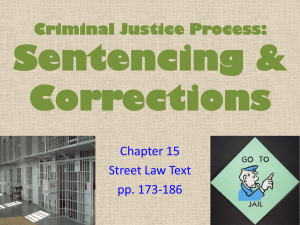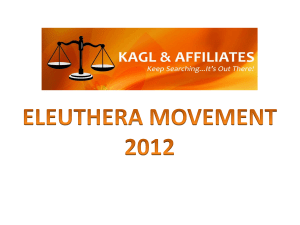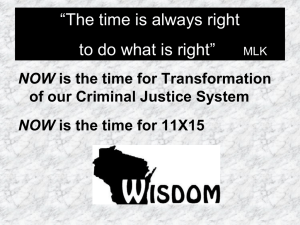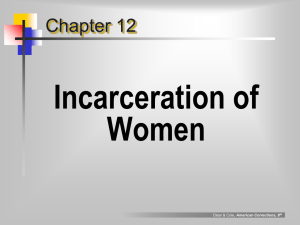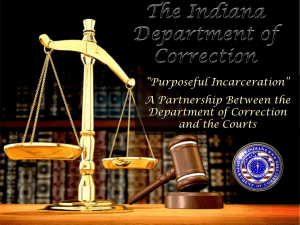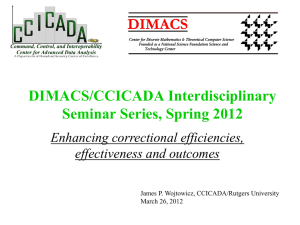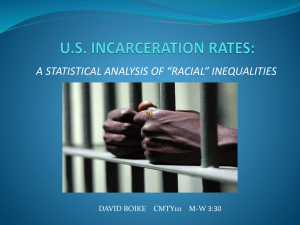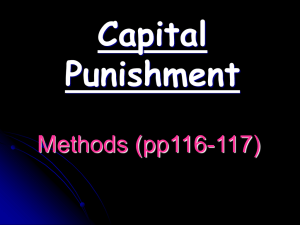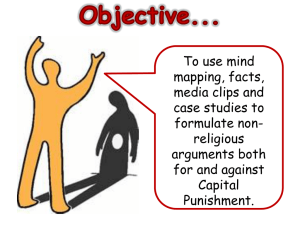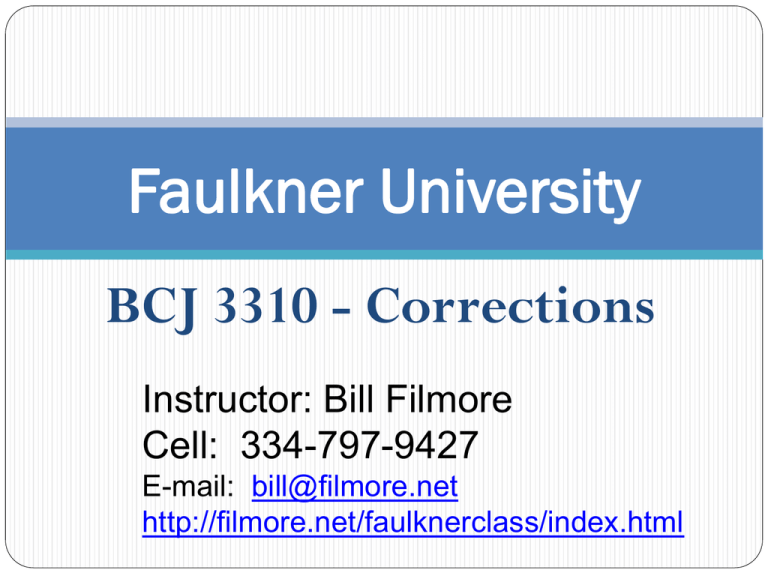
Faulkner University
BCJ 3310 - Corrections
Instructor: Bill Filmore
Cell: 334-797-9427
E-mail: bill@filmore.net
http://filmore.net/faulknerclass/index.html
Chapter 1
The Corrections System
Learning Objectives – Chpt. 1
1. Describe the range of purposes served by the
2.
3.
4.
5.
corrections system.
Define the systems framework and explain why it is
useful.
Name the various components of the corrections
system today and describe their functions.
Identify at least five key issues facing corrections today.
Discuss what we can learn from the “great experiment
of social control.”
Corrections Statistics
In 2008, U.S. imprisonment rate was 506 per
100,000.
Over 3,200 people on death row.
14,000 serving life sentences.
Considering all forms of corrections, more than
3% of all adults under some form of correctional
control.
Little relationship between prison population and
crime rate.
Corrections Statistics
In 2009, over 7.2 million people were on probation, in jail or prison,
or on parole at year end — 3.1% of all U.S. adult residents or 1 in
every 32 adults. The total correctional population declined (down
0.7% or 48,800 offenders) during 2009, the first decline observed in
the population since the Bureau of Justice Statistics began reporting
this population in 1980.
At year end 2009 a total of 4,203,967 adult men and women were on
probation and 819,308 were on parole or mandatory conditional
release following a prison term.
State and federal prison authorities had jurisdiction over 1,613,740
prisoners at yearend 2009: 1,405,622 under state jurisdiction and
208,118 under federal jurisdiction.
Local jails held 760,400 adults awaiting trial or serving a sentence at
midyear 2009.
Adults Under Corrections
Adult Correctional Population
% Adults – Correctional Supervision
Almost 5% of
the adult males
and 1% of the
adult females
in the United
States were
under some
form of
correctional
supervision in
1997.
Learning Objective 1
Learning Objective 1: Describe the
range of purposes served by the
corrections system.
Learning Objective 1
Purposes:
Protecting society by punishing people who
break society’s rules.
Help define the limits of behavior so
everyone understands what is permissible.
Central purpose is to carry out the criminal
sentence.
Learning Objective 2
Learning Objective 2: Define the systems
framework and explain why it is useful.
Learning Objective 2
A system is a complex whole consisting of
interdependent parts whose operations are directed
toward common goals and influenced by the
environment in which they function.
◦ Goals
◦ Interconnectedness
◦ Environment
◦ Feedback
◦ Complexity
Learning Objective 2
Goals:
Punishment
Protection
When these two functions do not
correspond, corrections faces goal
conflict.
Learning Objective 2
Interconnectedness:
Corrections can be viewed as a series of
processes:
Sentencing
Classification
Supervision
Programming
Revocation
Offenders pass through system in an assembly
line with return loops.
Learning Objective 2
Environment:
Outside forces/influences:
Public opinion
Fiscal constraints
Law
Corrections has a reciprocal relationship
with its environment.
Learning Objective 2
Feedback:
Systems learn, grow, and improve
according to feedback.
System has trouble obtaining useful
feedback.
Correction system and environments
tend to over respond to failure but
remain less aware of success.
Learning Objective 2
Complexity
All types of activities come under
heading of corrections:
Pretrial drug treatment
Electronically monitored home
confinement
Work centers
Residential treatment programs
Learning Objective 3
Learning Objective 3: Name the
various components of the
corrections system today and
describe their functions.
Learning Objective 3
Subunits:
Probation officers
Halfway houses
Prisons
Subunits vary in:
Size
Goals
Clientele
Organizational structure
Learning Objective 3
Federalism
◦ A system of government in which power and
responsibilities are divided between a national
government and state governments.
Most correctional activity takes place at state
level, of all individuals in correctional system:
◦ 1% of individuals on probation at federal level.
◦ 10% on parole at federal level.
◦ 11% in prison at federal level.
Learning Objective 3
102 federal prisons, 1,719 state prisons
Prison
An institution for the incarceration of people
convicted of serious crimes, usually felonies.
Jail
A facility authorized to hold pretrial detainees
and sentenced misdemeanants for periods
longer than 48 hours.
U.S. - Cost of Corrections
"Direct expenditure for each of the major criminal justice functions
(police, corrections, judicial) has been increasing."
Costs of Corrections
In 2006, $68,747,203,000 was spent
on corrections."The average annual
operating cost per state inmate in 2001
was $22,650, or $62.05 per day;
among facilities operated by the Federal
Bureau of Prisons, it was $22,632 per
inmate, or $62.01 per day."
Alabama Crime Rate
Alabama Incarceration Rate
Alabama Probationers
Alabama Parolees
Alabama Corrections Costs
Alabama Prison Population
Learning Objective 4
Learning Objective 4: Identify at
least five key issues facing
corrections today.
Learning Objective 4
Five key issues facing corrections today:
Conflicting goals.
Adequate funding.
Making the bureaucracy of correctional services
more effective.
Coordinating correctional activity across
different agencies.
Dealing with correctional uncertainty.
Learning Objective 4
Conflicting goals:
Rehabilitation/Punishment
Political ideology:
Liberal
Conservative
Goals as vague generalities:
“Protect the public”
“Rehabilitate offenders”
Learning Objective 4
Adequate funding:
Corrections paid for by tax
revenues:
Vie for funding
Conflicts among branches and
levels of government.
Learning Objective 4
Effective bureaucracy:
Street-level bureaucrats
Limited resources
Bureaucratic model guarantees that
services are delivered only up to a point
and that goals are never fully achieved.
Learning Objective 4
• Coordinating correctional activity across
different agencies:
◦ Most correctional systems comprise several
loosely related organizations that are
themselves bureaucracies.
◦ Decision making dispersed.
◦ Great deal of policy is formally
interconnected.
◦ One agency determines the workload of the
next.
Focus on Alabama…
Focus on
Correctional
Practice
Correctional
Interconnectedness
in Alabama
Page 20-21 at
bottom
“Mass Transfer
Creates Crisis for
Alabama Prisons”
Learning Objective 4
Dealing with correctional
uncertainty:
Uncertain technologies
Uncertain correctional
strategies
Learning Objective 4
Uncertain technologies:
Technology:
A method of applying scientific knowledge to practical purposes in a
particular field.
Validity of approaches for treating offenders remain in doubt:
Group therapy
Behavior modification
Anger management
Learning Objective 4
Uncertain correctional strategies:
Greater emphasis on secondary technologies:
Design of a prison’s security apparatus
Computer-based offender-tracking system for probation
What happens to offenders?
Corrections gets its business from the courts but also from
itself.
Learning Objective 5
Learning Objective 5: Discuss what we
can learn from the “great experiment of
social control.”
Learning Objective 5
Great Experiment – Increase in prison
population:
◦ Effects on crime:
No likely effect
◦ Effects on society:
Damage to families and communities
◦ Pursuit of justice:
Have we become a more just society?
Chapter 2
The Early History of Correctional
Thought and Practice
Learning Objectives
1.
2.
3.
4.
5.
Understand the major forms of punishment from the
Middle Ages to the American Revolution.
Discuss the Age of Reason and how it affected corrections.
Understand the contribution of Cesare Beccaria and the
classical school.
Understand the contribution of Jeremy Bentham and the
utilitarians.
Discuss the work of John Howard and its influence on
correctional reform.
Learning Objective 1
Learning objective 1: Understand the
major forms of punishment from the
Middle Ages to the American
Revolution.
Learning Objective 1
Earliest known comprehensive statements of prohibited
behavior:
◦ Sumerian Law of Mesopotamia (3100 B.C.E)
◦The Sumerians were the first Mesopotamian
civilization.
◦They invented law, a system of resolving disputes
based on a code of rules and retribution by a central
authority rather than relying on private retribution. The
Code of Hammurabi (Babylonian) is generally believed
to be based on Sumerian law.
◦ Code of Hummurabi (1750 B.C.E) ….
Early Sources of the Criminal Law
Code of Hammurabi – an early set
of laws established by the
Babylonian king Hammurabi, who
ruled the ancient city from 1792 to
1750 B.C. – first body of law to
survive and be available for study.
Intended to establish property and
other rights crucial to the continued
growth of Babylon as a significant
commercial center.
Emphasis on retribution – penal
philosophy – attempt to keep cruelty
within bounds – before code:
revenge seeking victims punished
Early Roman Law
Early Roman Law derived from
the Twelve Tables – written circa
450 B.C. which regulated family,
religious, and economic life
Emperor Justinian I (A.D. 527565) – The Justinian Code –
contained elements of our
modern civil and criminal law and
influenced Western legal thought
through the Middle Ages
Laid the groundwork of European law.
Learning Objective 1
lex talionis:
◦ Law of retaliation; the principle that punishment
should correspond in degree and kind to the offense.
Secular law:
◦ The law of the civil society as distinguished from
church law.
Wergild:
◦ “Man money”; money paid to relatives of a murdered
person or to the victim of a crime to compensate
them and to prevent a blood feud.
Learning Objective 1
Main criminal punishments were penance and payment of
fines and restitution
◦ Lower-class offenders without money received physical
punishment at the hands of masters
Church was the dominant social institution
Benefit of Clergy:
◦ The right to be tried in an ecclesiastical court, where
punishments were less severe than those meted out by civil
courts, given the religious focus on penance and salvation.
Learning Objective 1
Five punishments common in Europe before the
1800s besides fines:
Galley Slavery
Imprisonment
Transportation
Corporal Punishment
Death
Learning Objective 1
Galley Slavery
Forced rowing of large ships or galleys
Imprisonment
House of Correction
Detention facility that combined the major elements of a
workhouse, poorhouse, and penal industry by both disciplining
inmates and setting them to work.
Learning Objective 1
Transportation
The practice of transplanting
offenders from the community to
another region or land, often a penal
colony.
Hulks:
Abandoned ships the English converted
to hold convicts during a period of
prison crowding between 1776 and
1790.
Learning Objective 1
Corporal Punishment and Death
Corporal Punishment
Punishment inflicted on the
offender’s body with whips or other
devices that cause pain.
Mutilation
o Removing hand or finger
o Slitting the nostrils
o Severing an ear
Branding
Hanging
Learning Objective 2
Learning objective 2: Discuss the Age of Reason
and how it affected corrections.
Learning Objective 2
The Enlightenment, or the Age of Reason
The 1700s in England and France, when concepts of
liberalism, rationality, equality, and individualism dominated
social and political thinking.
John Locke
Montesquieu
Voltaire
Learning Objective 2
The Enlightenment, or the Age of Reason
Advances in scientific thinking led to:
Observation
Experimentation
Technological development
Sir Isaac Newton
Scientific Revolution
Encouraged questioning of established institutions
Use of power of reason
Progress
Age of Reason
Impact on Corrections:
Classical school of criminology emerged:
Rational link between gravity of crime and
severity of punishment
Limitations on power of government
emphasized
Proposed system of graduated penalties
Age of Reason
Major shift in penal thought and practice
Penal codes rewritten to emphasize
adaption of punishment to the offender
Correctional practices moved from
inflicting pain to methods that would set
the individual on a path of honesty and
right living
Age of Reason
Penitentiary developed as an
institution where criminals could:
Be isolated from temptations of
society
Reflect on their offenses
Be reformed
Learning Objective 3
Learning objective 3: Understand the
contribution of Cesare Beccaria and the
classical school.
Learning Objective 3
Cesare Beccaria (1738-1794)
Italian scholar who applied the rationalist
philosophy of the Enlightenment to the
criminal justice system
True aim and only justification for punishment
is utility
First attempt to explain crime in secular, or
worldly, terms instead of religious terms
Learning Objective 3
Classical Criminology
School of criminology that views
behavior as stemming from free will, that
demands responsibility and
accountability of all perpetrators, and
that stresses the need for punishments
severe enough to deter others.
Classical Criminology
Main principles:
Basis of all social action must be the
utilitarian concept of the greatest good for
the greatest number of people.
Crime must be considered an injury to
society, and the only rational measure of
crime is the extent of the injury.
Classical Criminology
Main principles:
Prevention of crime is more important than
punishment for crimes. To prevent crime, laws must be
improved and codified so that citizens can understand
and support them.
Secret accusations and torture must be abolished.
Accused have a right to speedy trials and to humane
treatment before trial and right to bring forward
evidence on their behalf.
Classical Criminology
Main principles:
The purpose of punishment is crime
deterrence, not social revenge. Certainty and
swiftness in punishment, rather than severity
best secure this goal.
Imprisonment should be more widely
employed, and better physical quarters should
be provided, with prisoners classified by age,
sex, and degree of criminality.
Classical Criminology
Beccaria:
Punishment must be essentially
public, prompt, necessary, the least
possible in given circumstances,
proportionate to the crime, dictated
by laws.
Learning Objective 4
Learning objective 4: Understand the
contribution of Jeremy Bentham and the
utilitarians.
Learning Objective 4
Jeremy Bentham (1748-1832)
English advocate of utilitarianism
in prison management and
discipline. Argued for the
treatment and reform of
prisoners.
Learning Objective 4
Utilitarianism
Doctrine that the aim of all action
should be the greatest possible
balance of pleasure over pain, hence
the belief that a punishment inflicted
on an offender must achieve enough
good to outweigh the pain inflicted.
Bentham’s Views
Criminals were childlike or unbalanced, lacking the
self-discipline to control their passions by reason.
Behavior was not preordained, rather an exercise of
free will.
Crime not sinful but the result of improper
calculation.
Criminal law should be organized so that the
offender would derive more pain than pleasure from
a wrongful act.
Learning Objective 5
Learning objective 5: Discuss the work of
John Howard and its influence on
correctional reform.
Learning Objective 5
John Howard (1726-1790)
English prison reformer whose book The State
of Prisons in England and Wales contributed
greatly to the passage of the Penitentiary Act
of 1779 by the House of Commons.
County squire
Social activist
Sheriff of Bedfordshire
John Howard
Shocked by conditions in English
correctional facilities
Rallied legislative interest in reform
Major proponent of the penitentiary
English Parliament passed Penitentiary
Act of 1779 based on Howard’s
principles
Penitentiary Act of 1779
A secure and sanitary structure
Systematic inspections
Abolition of fees
Reformatory regimen
Chapter 3
The History of Corrections in America
Learning Objectives
1. Describe “The Great Law” of Pennsylvania and
note its importance.
2. Distinguish the basic assumptions of the
penitentiary system of Pennsylvania and New
York.
3. Discuss the elements of the Cincinnati
Declaration.
4. Understand the reforms advocated by the
Progressives.
Learning Objectives
5. Discuss the assumptions of the medical model,
regarding the nature of criminal behavior and its
correction.
6. Illustrate how the community model reflected
the social and political values of the 1960s and
1970s.
7. Describe the forces and events that led to the
present crime control model.
Learning Objective 1
Learning objective 1: Describe “The
Great Law” of Pennsylvania and note its
importance.
Learning Objective 1
• The Great Law of Pennsylvania
– Based on humane Quaker principles
and emphasized hard labor in a house
of correction as punishment for most
crimes.
• Death reserved for premeditated
murder
Penitentiary
An institution intended to isolate prisoners from
society and from one another so that they could
reflect on their past misdeeds, repent, and thus
undergo reformation.
◦ First appeared in 1790
◦ Philadelphia’s Walnut Street Jail
◦ American penitentiary attracted world attention
Tocqueville
Learning Objective 2
Learning objective 2: Distinguish the
basic assumptions of the penitentiary
system of Pennsylvania and New York.
Pennsylvania System Principles
(Separate Confinement)
1. Prisoners would not be treated vengefully but
should be convinced that through hard and
selective forms of suffering they could change
their lives.
2. Solitary confinement would prevent further
corruption inside prison.
3. In isolation, offenders would reflect on their
transgressions and repent.
Pennsylvania System Principles
4. Solitary confinement would be
punishment because humans are by nature
social beings.
5. Solitary confinement would be economical
because prisoners would not need long
periods of time to repent, and therefore
fewer keepers would be needed and the
costs of clothing would be lower.
New York (Auburn) System
• Congregate System
– Inmates held in isolation at night but worked with
other prisoners during the day under a rule of silence.
• Contract Labor System
– Inmate labor sold on a contractual basis to private
employers who provided the machinery and raw
materials with which inmates made salable products
in the institution.
Development in South and West
Lease System
Inmates leased to contractors who provided
prisoners with food and clothing in exchange
for their labor. In southern states, the prisoners
were used as field laborers.
Leasing program used extensively in California,
Montana, Oregon, and Wyoming until passage
of the Anti-Contract Law of 1887.
Learning Objective 3
Learning objective 3: Discuss the
elements of the Cincinnati Declaration.
Cincinnati Declaration of Principles
1870 Meeting of the National Prison Association:
Prison operations should stem from a
philosophy of inmate change, with reformation
rewarded by release.
Indeterminate length sentences replaced by
fixed sentences.
Reformation, rather than lapse of time
necessary for prisoner’s release.
Cincinnati Declaration of Principles
Classification of prisoners on the basis
of character and improvement.
Penitentiary practices of fixed
sentences, the lockstep, rules of
silence and isolation seen as debasing
and humiliating.
Learning Objective 4
Learning objective 4: Understand the
reforms advocated by the Progressives.
Learning Objective 4
Progressives
Group that attacked the excesses of big
business and placed their faith in state
action to deal with the social problems of
slums, adulterated food, dangerous
occupational conditions, vice, and crime.
Members of the positivist school of
criminology
Positivist School
Human behavior is a product of biological,
economic, psychological, and social factors
and that the scientific method can be
applied to ascertain the causes of individual
behavior.
Positivist School Assumptions
• Criminal behavior is not the result of free will
but stems from factors over which the individual
has no control:
– Biological characteristics
– Psychological maladjustments
– Sociological conditions
• Criminals can be treated so that they can lead
crime-free lives.
• Treatment must center on the individual and the
individual’s adjustment.
Progressive Reforms
Probation
Recognized individual differences and allowed
offenders to be treated in the community under
supervision.
Indeterminate Sentences
Minimum and maximum terms, within which
the correctional process of rehabilitation could
operate.
Parole
Learning Objective 5
Learning objective 5: Discuss the assumptions
of the medical model, regarding the nature of
criminal behavior and its correction.
Learning Objective 5
Medical model
Assumption that criminal behavior is caused by
social, psychological, or biological deficiencies
that require treatment.
1929:
Congress authorized the Federal Bureau of
Prisons to develop institutions to ensure proper
classification, care, and treatment of offenders.
Learning Objective 5
1950s came to be known as the Era of
Treatment.
Prisons were to become something like
mental hospitals that would rehabilitate and
test the inmate for readiness to reenter
society.
Learning Objective 6
Learning objective 6: Illustrate how the
community model reflected the social
and political values of the 1960s and
1970s.
Learning Objective 6
Social and political values of 1960s and 1970s:
Civil rights movement
War on poverty
Resistance to the Vietnam War
Americans challenged government institutions
dealing with:
Education
Mental health
Juvenile delinquency
Adult corrections
Learning Objective 6
Community corrections
Reintegrating the offender into the community
should be the goal of the criminal justice system.
Attica Prison Riot
Officials urged to make decarceration through
community corrections the goal and make greater
use of alternative such as:
Probation
Halfway houses
Community service
Attica Prison Riot
Learning Objective 7
Learning objective 7: Describe the
forces and events that led to the
present crime control model.
Learning Objective 7
Crime control model of
corrections:
Criminal behavior can be
controlled by more use of
incarceration and other forms of
strict supervision.
Learning Objective 7
Reasons for return to crime control model:
Political climate change in 1970s and 1980s
Crime rate at historic levels
Response by legislators, judges, criminal
justice officials
By 1980, crime and punishment became
intense subject for ideological conflict,
partisan politics, legislative action.
Next Week:
Chapter 4: Punishment of Offenders
Chapter 5: Law of Corrections
Chapter 6: Correctional Client
http://filmore.net/faulknerclass/index.html

